- Home
- A-Z Publications
- Current Organic Synthesis
- Previous Issues
- Volume 21, Issue 5, 2024
Current Organic Synthesis - Volume 21, Issue 5, 2024
Volume 21, Issue 5, 2024
-
-
Synthesis of Phentermine and its Derivatives
More LessAuthors: Khushbu Upadhyaya, Shruti Shukla, Bharti P. Meena and Jaya DwivediIn recent years, a growing global concern has been obesity. Patients with obesity are at major risk for developing a number of diseases. These diseases may significantly impact patient’s daily lives and increase the mortality rate. Over a year, medication for obesity has undergone substantial changes. An amphetamine-like prescription drug called Phentermine (Adipex-P, Lomaira) is used to suppress appetite. In the Read More
-
-
-
A Bird's Eye Review of Recent Reports on 1,3,4-oxadiazoles' Anti-inflammatory Insights Perspectives
More LessAuthors: Tarun Chaudhary and Prabhat K. UpadhyayAnti-inflammatory agents suppress inflammatory mediators such as prostaglandins, prostacyclins, cytokines, thromboxane, histamine, bradykinins, COX-I and COX-II, 5-LOX, and other substances. These inflammatory chemicals create inflammatory responses when tissue is injured by trauma, bacteria, heat, toxins, or other factors. These inflammatory reactions may result in fluid flow from the blood vessels into the tissues, res Read More
-
-
-
Iodoxybenzoic Acid (IBX) in Organic Synthesis: A Septennial Review
More LessAuthors: Ravi Varala, Vittal Seema, Mohammed M. Alam, Narsimhaswamy Dubasi and Rama Devi VummadiThis study reviews the oxidative applications of 2-iodoxybenzoic acid (IBX) in organic synthesis, focusing on C-H functionalization, hetero-hetero bond formations, ring cleavage reactions, dehydrogenation, heterocyclic ring formations, and some miscellaneous reactions in a comprehensive and critical way. It compiles the literature starting from mid-2015 to date.
-
-
-
The Golden Spice for Life: Turmeric with the Pharmacological Benefits of Curcuminoids Components, Including Curcumin, Bisdemethoxycurcumin, and Demethoxycurcumins
More LessAuthors: Mohamad H. Shahrajabian and Wenli SunBackground: Turmeric (Curcuma longa L.), belonging to the Zingiberaceae family, is a perennial rhizomatous plant of tropical and subtropical regions. The three major chemical components responsible for the biological activities of turmeric are curcumin, demethoxycurcumin, and bisdemethoxycurcumin. Methods: The literature search included review articles, analytical studies, randomized control experiments, an Read More
-
-
-
Novel Penicillin Derivatives Against Selected Multiple-drug Resistant Bacterial Strains: Design, Synthesis, Structural Analysis, In Silico and In Vitro Studies
More LessIntroduction: The rising numbers of multiple drug-resistant (MDR) pathogens and the consequent antibacterial therapy failure that resulted in severe medical conditions push to illustrate new molecules with extended activity against the resistant strains. In this manner, chemical derivatization of known antibiotics is proposed to save efforts in drug discovery, and penicillins serve as an ideal in this regard. Methods: Read More
-
-
-
Organocatalytic Synthesis of (Hetero)arylidene Malononitriles Using a More Sustainable, Greener, and Scalable Strategy
More LessAuthors: Suzaimi Johari, Mohd Rafie Johan and Nader Ghaffari KhalighAim and Objective: The establishment of a green and sustainable Knoevenagel condensation reaction in organic chemistry is still crucial. This work aimed to provide a newly developed metal-free and halogen-free catalytic methodology for the synthesis of CS and (hetero-) arylidene malononitriles in the laboratory and industrial scale. The Knoevenagel condensation reaction of various carbonyl groups with malononitr Read More
-
Volumes & issues
-
Volume 22 (2025)
-
Volume 21 (2024)
-
Volume 20 (2023)
-
Volume 19 (2022)
-
Volume 18 (2021)
-
Volume 17 (2020)
-
Volume 16 (2019)
-
Volume 15 (2018)
-
Volume 14 (2017)
-
Volume 13 (2016)
-
Volume 12 (2015)
-
Volume 11 (2014)
-
Volume 10 (2013)
-
Volume 9 (2012)
-
Volume 8 (2011)
-
Volume 7 (2010)
-
Volume 6 (2009)
-
Volume 5 (2008)
-
Volume 4 (2007)
-
Volume 3 (2006)
-
Volume 2 (2005)
-
Volume 1 (2004)
Most Read This Month
Article
content/journals/cos
Journal
10
5
false
en


